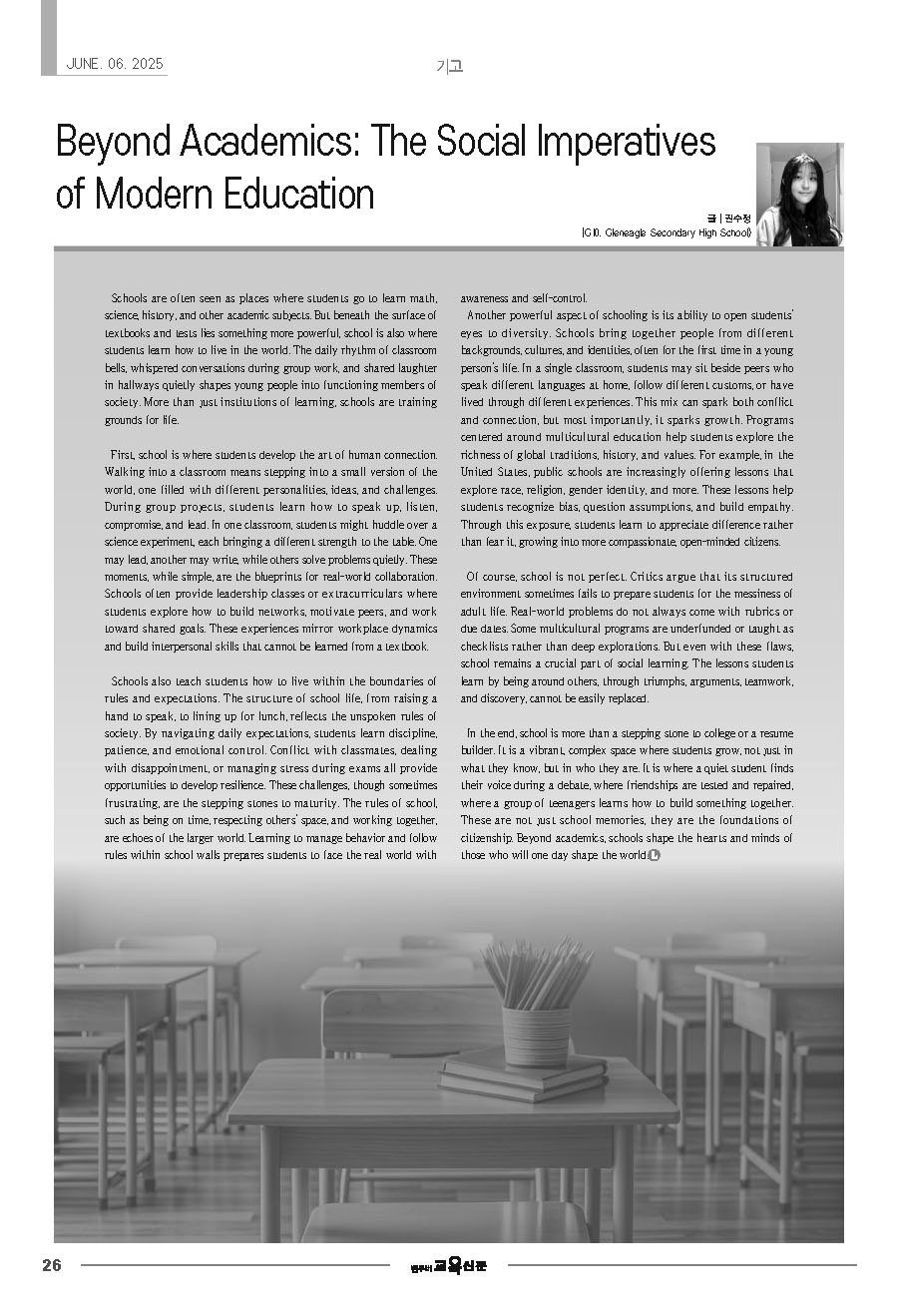
글 권수정 (G10. Gleneagle Secondary High School)
Schools are often seen as places where students go to learn math, science, history, and other academic subjects. But beneath the surface of textbooks and tests lies something more powerful, school is also where students learn how to live in the world. The daily rhythm of classroom bells, whispered conversations during group work, and shared laughter in hallways quietly shapes young people into functioning members of society. More than just institutions of learning, schools are training grounds for life.
First, school is where students develop the art of human connection. Walking into a classroom means stepping into a small version of the world, one filled with different personalities, ideas, and challenges. During group projects, students learn how to speak up, listen, compromise, and lead. In one classroom, students might huddle over a science experiment, each bringing a different strength to the table. One may lead, another may write, while others solve problems quietly. These moments, while simple, are the blueprints for real-world collaboration. Schools often provide leadership classes or extracurriculars where students explore how to build networks, motivate peers, and work toward shared goals. These experiences mirror workplace dynamics and build interpersonal skills that cannot be learned from a textbook.
Schools also teach students how to live within the boundaries of rules and expectations. The structure of school life, from raising a hand to speak, to lining up for lunch, reflects the unspoken rules of society. By navigating daily expectations, students learn discipline, patience, and emotional control. Conflict with classmates, dealing with disappointment, or managing stress during exams all provide opportunities to develop resilience. These challenges, though sometimes frustrating, are the stepping stones to maturity. The rules of school, such as being on time, respecting others’ space, and working together, are echoes of the larger world. Learning to manage behavior and follow rules within school walls prepares students to face the real world with awareness and self-control.
Another powerful aspect of schooling is its ability to open students’ eyes to diversity. Schools bring together people from different backgrounds, cultures, and identities, often for the first time in a young person’s life. In a single classroom, students may sit beside peers who speak different languages at home, follow different customs, or have lived through different experiences. This mix can spark both conflict and connection, but most importantly, it sparks growth. Programs centered around multicultural education help students explore the richness of global traditions, history, and values. For example, in the United States, public schools are increasingly offering lessons that explore race, religion, gender identity, and more. These lessons help students recognize bias, question assumptions, and build empathy. Through this exposure, students learn to appreciate difference rather than fear it, growing into more compassionate, open-minded citizens.
Of course, school is not perfect. Critics argue that its structured environment sometimes fails to prepare students for the messiness of adult life. Real-world problems do not always come with rubrics or due dates. Some multicultural programs are underfunded or taught as checklists rather than deep explorations. But even with these flaws, school remains a crucial part of social learning. The lessons students learn by being around others, through triumphs, arguments, teamwork, and discovery, cannot be easily replaced.
In the end, school is more than a stepping stone to college or a resume builder. It is a vibrant, complex space where students grow, not just in what they know, but in who they are. It is where a quiet student finds their voice during a debate, where friendships are tested and repaired, where a group of teenagers learns how to build something together. These are not just school memories, they are the foundations of citizenship. Beyond academics, schools shape the hearts and minds of those who will one day shape the world.




